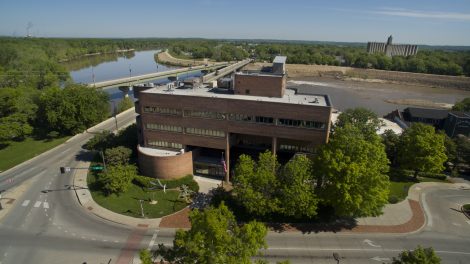City leaders approve spending plan for $1.5M in federal CDBG/Home funds, restoring some funding to neighborhood associations

photo by: Nick Krug
Lawrence City Hall, 6 E. Sixth St., is pictured on May 3, 2016.
City leaders have approved a plan for spending more than $1.5 million in federal funding from the Community Development Block Grant and Home Investment Partnerships programs, including restoring some of the funding previously cut from neighborhood associations.
As part of its meeting this week, the Lawrence City Commission voted unanimously to approve the 2020 spending plan, which allocates $1.53 million for various community and social service organizations as well as neighborhood associations in low-to moderate-income areas. The originally proposed plan included significant reductions in the funds allocated to neighborhood associations, and the commission voted to restore some of that funding.
Commissioner Courtney Shipley, who was formerly the chair of the Lawrence Neighborhood Association, said that neighborhood associations are not 501(c)(3) organizations, a type of nonprofit, like many of the other organizations they were scored against, and therefore don’t have the ability to apply for grants that are available to such organizations. Shipley said the few thousand dollars requested by each low-to-moderate income neighborhood association was by comparison a very small percentage of the overall federal funding pool.
“I just feel like a little redistribution would give it a little more balance,” Shipley said.
The neighborhood associations received less funding than past years because they received the lowest scores from a new evaluation and scoring system used to allocate the funding. Previously, a city advisory board made the funding recommendations, and this is the first year that city staff used the matrix to make funding recommendations. Various neighborhood residents and neighborhood association leaders sent correspondence and spoke to the commission, expressing support for the associations and the role they play in residents’ lives and asking the commission to maintain the funding previously provided.
Pinckney Neighborhood Association President Bart Littlejohn spoke and wrote to the commission, saying that the funds help the association to foster a sense of community and connection for the people of Pinckney neighborhood. Littlejohn said the funding reduction would mean the association would struggle to maintain the same effectiveness as before and urged the commission to increase the allocation.
Other commissioners agreed with Shipley and the suggestion to reallocate some funding away from social service organizations to the neighborhood associations. Mayor Jennifer Ananda said reducing funding for the social services organization was tough given the current coronavirus crisis in the country, but that neighborhood associations help the community in a different way.
Ultimately, out of the $1.53 million in total funding, the commission voted to remove $1,000 from Catholic Charities of Northeast Kansas, $2,000 from The Salvation Army and $1,000 from Success by Six Coalition of Douglas County. The commission voted unanimously to distribute the $4,000 evenly among the four low-to-moderate income neighborhood associations that applied for funding.
The additional $1,000 brought the allocation for the Brook Creek Neighborhood Association to $3,032, the East Lawrence association allocation to $3,169, the Pinckney association allocation to $2,889 and the Schwegler association allocation to $2,581. The reductions brought the allocation for Catholic Charities to $14,000, the Salvation Army to $23,000 and Success by Six to $13,000.
East Lawrence Neighborhood Association Phil Collison also wrote to the commission about the role neighborhood associations play. He noted the association takes on a lot of roles, including hosting community gatherings, providing a low-cost lawn mower and tiller rental, supporting neighborhood art and providing input on projects that affect the neighborhood. Collison later told the Journal-World that he didn’t think the city’s scoring system could capture all of those intangible elements.
“We bring people a sense of place and a sense of belonging, and we are open to anyone who wants to participate,” Collison said.
He said he thought the new scoring process was flawed and didn’t properly account for the community value of neighborhood associations or for the commission’s commitment to strengthening neighborhoods, which is part of the commission’s strategic plan. He said he hoped the scoring process would be reconsidered and improved before the funding allocation next year.







